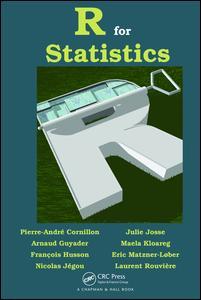Description
R for Statistics
Authors: Cornillon Pierre-Andre, Guyader Arnaud, Husson Francois, Jegou Nicolas, Josse Julie, Kloareg Maela, Matzner-Lober Eric, Rouvière Laurent
Language: English
Subject for R for Statistics:
Keywords
Vec1 Vec2; FALSE FALSE; An Overview of R; FALSE FALSE FALSE; Statistical Methods; Agrocampus Ouest; Preparing Data; Min 1Q Median 3Q Max; Making Programs with R; PLS; Hypothesis Test; Multiple Correspondence Analysis; FactoMineR Package; Residual Standard Error; Classification Error Rate; Explanatory Qualitative Variable; Qualitative Variable; Mass Package; Mac OS; Active Data Set; PLS Regression; AHC; PLS Component; ANOVA Table; TRUE FALSE FALSE FALSE FALSE; NA NA NA NA; NA NA NA; Shapiro Wilk Test; Ozone Dataset; Alternative Hypothesis H1
220.72 €
In Print (Delivery period: 14 days).
Add to cartPublication date: 09-2017
· 15.6x23.4 cm · Hardback
66.20 €
In Print (Delivery period: 15 days).
Add to cartPublication date: 04-2012
318 p. · 15.6x23.4 cm · Paperback
Description
/li>Contents
/li>Readership
/li>Biography
/li>
Although there are currently a wide variety of software packages suitable for the modern statistician, R has the triple advantage of being comprehensive, widespread, and free. Published in 2008, the second edition of Statistiques avec R enjoyed great success as an R guidebook in the French-speaking world. Translated and updated, R for Statistics includes a number of expanded and additional worked examples.
Organized into two sections, the book focuses first on the R software, then on the implementation of traditional statistical methods with R.
Focusing on the R software, the first section covers:
- Basic elements of the R software and data processing
- Clear, concise visualization of results, using simple and complex graphs
- Programming basics: pre-defined and user-created functions
The second section of the book presents R methods for a wide range of traditional statistical data processing techniques, including:
- Regression methods
- Analyses of variance and covariance
- Classification methods
- Exploratory multivariate analysis
- Clustering methods
- Hypothesis tests
After a short presentation of the method, the book explicitly details the R command lines and gives commented results. Accessible to novices and experts alike, R for Statistics is a clear and enjoyable resource for any scientist.
Datasets and all the results described in this book are available on the book?s webpage at http://www.agrocampus-ouest.fr/math/RforStat




